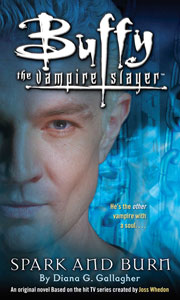In the early days of the “Buffy” novels, we got the points of view of supporting characters – as well as a chance to revisit episodes prior to syndication and home video – in series such as “The Angel Chronicles,” “The Xander Years” and “The Willow Files.” Diana G. Gallagher’s “Spark and Burn” (July 2005) brings back that format, and attempts to spice it up, as Spike wallows in the Sunnydale High basement in early Season 7. As he’s harassed by The First, he thinks back on the events of Season 2, when he enters Buffy’s sphere.
I suspect Gallagher intended to make this a much bigger novel but got stopped by page count or deadline. The inside cover’s “based on” list includes many episodes that aren’t referenced in “Spark and Burn.” As it stands, the through-line feels forced yet incomplete. Gallagher tries to sell the idea that Spike is obsessed with killing Buffy in Season 2, and then contrast that with the closing statement: that Buffy’s goodness has rubbed off on Spike and he’s ready to sacrifice himself to save the world in Season 7.
But I’ve always gotten the sense that the Big Bads of Seasons 1-5 are not concerned with Buffy, at least not initially, and not to the degree presented here. Not that the villains discount her by any means, but they are more focused on their evil plans than specifically thwarting the Slayer and her allies.
Particularly strange are Gallagher’s takes on “Inca Mummy Girl” (2.4) and “Reptile Boy” (2.5). Spike isn’t in those episodes, but she imagines he is lurking in the shadows “Rosencrantz and Guildenstern”-style, and observing the Scooby Gang. But the effect is world-shrinking instead of humor. The author reshapes the TV trope that the bad guy is always thwarted just short of killing the hero, which we all accept without much thought, into the notion that Spike could’ve killed Buffy several times in Season 2 but something stops him from doing so.
To her credit, Gallagher doesn’t try to rewrite the saga as Spike being in love with Buffy that far back. What makes Spike’s Season 5 arc so entertaining is his “Oh my god I think I like you” (to quote “Crazy Ex-Girlfriend”) realization regarding Buffy. The author very lightly teases the notion that Drusilla, through her precognition, suspects Buffy’s effect on Spike’s psyche; because Dru is a big-time nutcase (even by her standards) in Season 2, I’ll allow this little moment.
For much of “Spark and Burn,” Spike is trying to track down the Du Lac manuscript, which contains the spell for restoring Dru’s strength. This novel doesn’t say how Dru got sick, and it stops short of the point — in “What’s My Line, Parts One and Two” (2.9 and 2.10) – when his minion steals the book from Giles and (after a complex series of events) Dru is healed. Even for someone who has viewed the TV series and doesn’t need the narrative retold, which presumably is most readers, “Spark and Burn’s” treatment of this thread is unsatisfying.
Other things feel like missed opportunities. Spike just kind of realizes and accepts that Angel has a soul in Season 2, but it might’ve been nice to have him look back on the World War II adventure “Why We Fight” (“Angel” 5.13) with an eye entirely on Angel’s soul-having behavior in retrospect. Gallagher does revisit this episode, but only briefly and without a fresh perspective on the events.
Gallagher uses “Halloween” (2.6) as the final statement on Spike’s view of Buffy in Season 2. The author downplays Spike’s glee (“Well, this is just … neat!”) in that episode and imagines Buffy’s weakness while under Ethan’s spell as the reason he stops short of killing her. Spike is quite bothered by Buffy’s weakened state in “Spark and Burn.”
On page 227, he observes the timid Buffy in her 17th century noblewoman’s costume:
“I love it,” Spike said calmly, but that was a lie.
And a page later, Buffy gets her powers back:
“Hi, honey, I’m home” (Buffy said).
God, I love this one! The thought was barely formed in Spike’s mind before the Slayer punched him in the stomach.
“Spark and Burn” tries to do too much – to comment on Spike’s link to Angel (via having souls) and his link to Buffy (via her example rubbing off on him) – without fully achieving its aims. I think this might’ve been an impossible task anyway, because the truth of the matter is that Spike doesn’t think that much about Angel having a soul (aside from being disgusted by it) until he likewise acquires one (as chronicled in “Buffy” Season 7 and “Angel” Season 5). And he doesn’t think that much about Buffy (aside from her being a Slayer he should be wary of) until he falls in love with her in Season 5.
Gallagher aims to create a more streamlined inner journey for Spike that doesn’t exist. Oddly, it’s perhaps a good thing that the effort comes off as half-hearted anyway, as we can view “Spark and Burn” as a harmless failed experiment.
Click here for an index of all of John’s “Buffy” and “Angel” reviews.


